Household appliances are not only comfort and convenience, but also a headache if something does not work. For example, you urgently need to heat up frozen food, and suddenly the heating of the microwave does not work.
Any modern electronic equipment is complex in design and principle of operation, you have to carefully understand the reasons for the failure step by step.
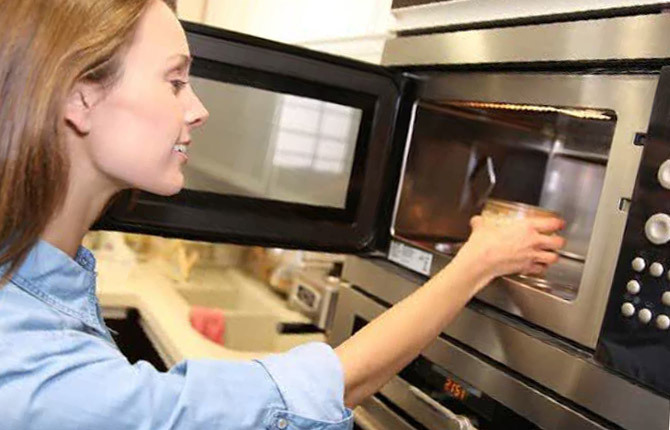
The content of the article:
- Why is the microwave not heating?
-
Common Simple Problems
- Insufficient voltage
- Technical difficulites
- Door
- Wrong mode
-
Complex problems
- Fuse
- Magnetron
- mica plate
- Capacitor
- Diode
- Timer
- Transformer
- inverter
- Control block
-
DIY repair
- Checking the high voltage fuse
- Capacitor check
- High Voltage Diode Test
- Magnetron protection test
- Checking the door sensor
- Fault Prevention
Why is the microwave not heating?
It is possible to reliably determine the reasons for the lack of heating only during the sequential check of all the most important elements of the microwave oven. Therefore, the process of diagnosing the reasons why it does not heat microwaveshould be divided into 3 steps:
- We check the list of the most common reasons why a microwave oven may not work (this is approximately 80% of all failure cases).
- We consider external factors that do not depend on the state of the microwave.
- If you have not found the reason why the device does not work, you will have to check the most vulnerable components of the microwave.
In about half of the cases, the microwave stopped heating for external reasons. For example, a blockage is triggered, the power cord is broken, dirt and grease got inside the microwave unit. If the stove is with a grill, then the problem may be related to the destruction of the overheated part or the melting of the contacts, shorting the insulation.
Common Simple Problems
The search for a breakdown should begin with the simplest cause. For example, a break in the power cord, a core inside the cable or at the place where the power is soldered with a fuse. You can use a multimeter to check, but first you just need to wiggle the cord. If the light inside appeared, the fan and heating started working, then they change the cord, and at the same time they check how the outlet itself works.
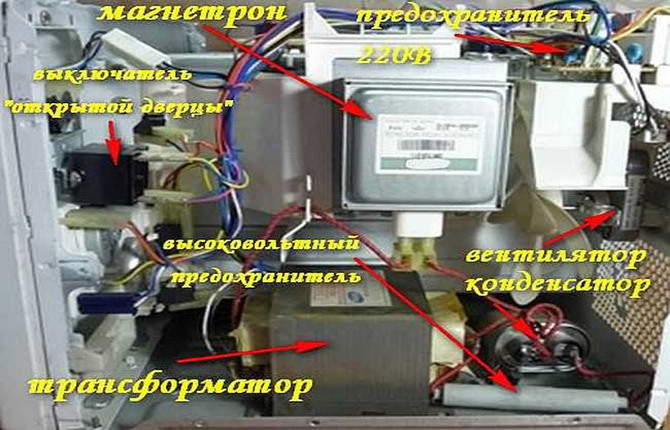
Insufficient voltage
If heating does not appear, then it is necessary to determine whether electricity is supplied to the microwave, measure the supply voltage at the input terminals of the power supply.
To do this, unplug the microwave from the mains, turn it off, unplug the cord from the outlet, and open the door to ensure that the heating is blocked if the device accidentally starts during the dismantling process covers.
Next, find the place to seal the power cord and check the voltage. If there is no network, plug the plug into another outlet and check again if the heating works. If not, replace the cord.
Perhaps the microwave is not working due to low mains voltage. This happens if the house is located in the suburbs or in the countryside. Even worse, if the voltage in the network "jumps" due to the fact that the neighbors regularly turn on a powerful circular machine, an electric boiler or a heater in the bath. In this case, a zener diode or a system of several relays may fail on the input circuit of the power supply.
The stabilized power supply is designed for a lower voltage threshold of 180 V, therefore, for stable heating you will need to connect the microwave through a relay or slide voltage stabilizer, with a power of at least 3 kW.
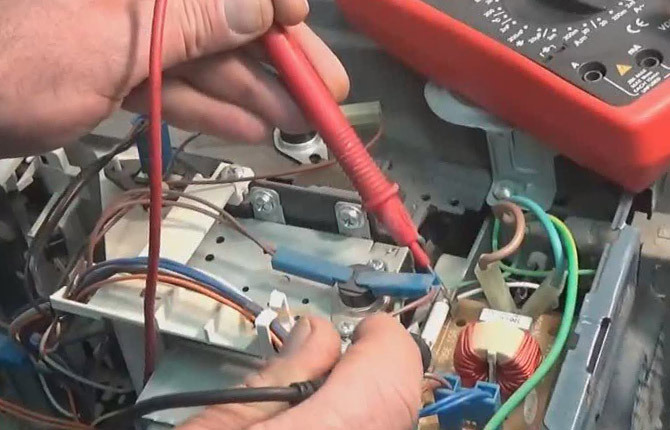
Technical difficulites
In addition to easily eliminated and obvious reasons why the microwave oven stopped heating, there are hidden damages (mechanical and electrical). For example, the fan, the cooling magnetron and the radiator burned out.
Without blowing the power unit (magnetron and transformer), the microwave does not work, and even if the “cold” device starts, the heating will work for a few seconds, after which the thermal relay will work.
Door
Often the reason for the lack of heating is a sensor or contact that unlocks power when the door is closed. After all, heating in a working microwave oven only works when the chamber door is closed.
2 situations are possible:
- The latch with contact "hung" in the "open" position due to accumulated fatty contamination. This means that the supply chain is broken. Heating will not work in any position of the door.
- The latch is stuck in the "closed" position. The most dangerous situation. The electrical circuit of the sensor that controls the heating operation is closed.
In this case, if you accidentally or carelessly open the door, then during the operation of the microwave oven, you can get severe burns from the microwave magnetic field. Therefore, for any checks on the operation of the heating or just the power cord, the voltage on the contacts, the door must be closed before starting.
Wrong mode
Heating can stop even during the operation of a functional, at first glance, microwave oven. For example, they put cold food in the chamber and turned on the heat. But in the end it turns out that the microwave does not heat the food. Ice crust does not conduct electricity.
The problem lies in the microwave device itself. In order for the heating to work, it is necessary that the radiated microwave waves are absorbed by the products, converting electromagnetic energy into heat.
If you choose the wrong mode, then a situation will arise in the chamber when the microwave oven works, but does not heat. Radiated microwave energy is not absorbed (very dry, very frozen or dehydrated foods). This situation is also called a reflected wave or lack of magnetic flux coupling.
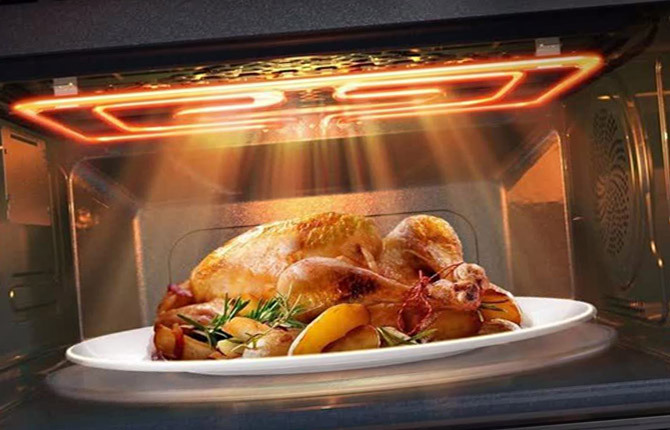
As a result of the operation of the microwave, heating does not occur, and all the energy is discharged on the magnetron and the high-voltage transformer. A few seconds of operation in this mode of Samsung or LG microwaves is guaranteed to damage the magnetron. Some models, such as Orion, will simply stop heating food to the desired temperature.
Complex problems
In order to restore heat, you will need at least:
- Electrical diagram with details of the components used, electronic components, indicating the brand and denomination.
- Multimeter for checking parts and measuring voltages (current).
- Screwdriver with interchangeable slotted and cross bits.
It is possible to work with a microwave oven only under the condition of the end (or absence) of the warranty from the service workshop. Household appliances, like a microwave oven, are repaired by replacing entire components, and their cost is quite high.
In some cases, for example, for Samsung microwaves, delivery of parts must be ordered and waited for weeks. Therefore, experiments with the repair and restoration of heating are allowed only on old microwave ovens.
Fuse
In any microwave there are at least 2 of them, but there can be 3 if the design has a grill. But only a fuse at the power input and one more high-voltage device that protects the HV transformer are responsible for microwave heating. To check if the fuse is the cause of the breakdown, it must be dismantled.
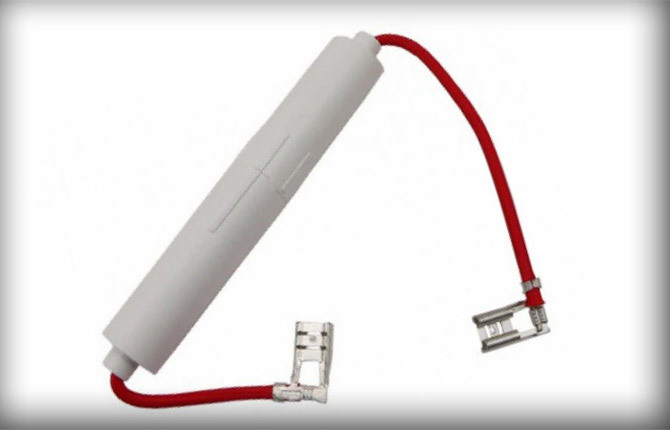
To get to the fuse, you need to remove the back or top cover of the case (for different models of microwaves, access to the nodes is organized differently). The mains fuse is installed on clips next to the power cord contacts. You need to remove it and check with a multimeter for a break.
If there is no device, then you can check the heating by temporarily shorting the contacts. If the microwave heating works, then the blown fuse is replaced with a new one.
The second fuse is installed in the circuit between the magnetron and the high voltage transformer. As a rule, this is a plastic tube body. Inside there is a glass fuse with a fusible link.
If destruction has occurred, then dark points of burnout of the insert and a spring that has moved to one side will be visible on the surface of the glass.
The HV fuse is calibrated for resistance at the factory during the manufacturing process. Therefore, it is purchased for a specific microwave model. Any attempt to short the contacts of the HV fuse to see if the heat will work will damage the transformer or magnetron.
Magnetron
The most difficult to diagnose. The magnetron is designed to generate electromagnetic waves in the microwave range, which provide heating of products in the chamber. If the power to the high voltage transformer is unstable, the magnetron will overheat.
In order for the device to work at the same temperature, it is installed on an aluminum radiator, plus the blower fan works. Therefore, if there is no heating and the fan does not work, then most likely the problem is in the magnetron, and specifically in the capacitor inside it.

Magnetrons can only be repaired in a specialized workshop. You can try to fix the breakdown with your own hands, but the device will still not work like new, and if the repair is poor, the microwave may catch fire.
mica plate
The size of the part can be different, the thickness is 0.6-1.1 mm. The mica plate closes the waveguide window, through which microwave radiation enters the chamber with products from the magnetron.
If necessary, mica can be temporarily removed. Any new microwave can work without a mica screen. But the heating will be uneven, it heats badly. Over time, mica burns out (due to heating of fatty deposits on it), respectively, all water-fat vapors get inside the waveguide and magnetron. The stove starts to work with sparks and noise. As a result, everything ends with damage to high-voltage parts.
The plate can be bought at any workshop, you just need to know the dimensions.
Capacitor
There are 2 in the microwave. One is installed on the input block after the fuse and performs the functions of a surge protector. The dimensions of the capacitor are large, the capacitance is usually measured in tens of microfarads.
The accumulated charge is enough to, touching your hand, get a strong electric shock. Therefore, before disassembling and checking the parts, it is imperative to unplug the cord from the network and close the contacts on the capacitor (discharge).
If a spark “clicks” when touched with a screwdriver with an insulated handle, then the device is working. The part can be checked with a multimeter.
The second high-voltage capacitor stands in the circuit next to the transformer. Most often, because of it, the heating in the microwave does not work. It is necessary to dismantle and measure the resistance.
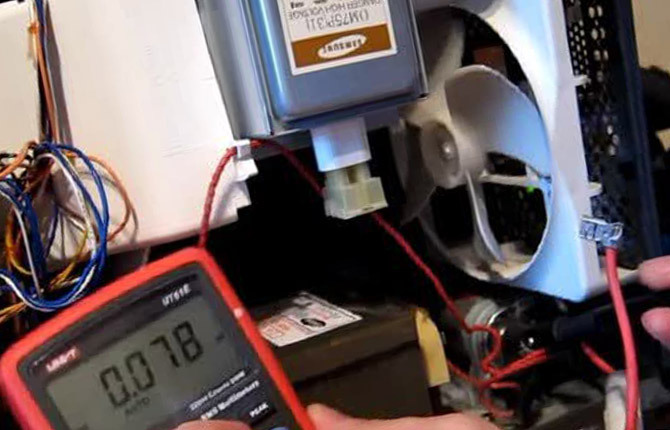
Diode
A high-voltage diode is installed next to the capacitor. It is difficult to determine whether a part works or not in domestic conditions. The only sign indicating a malfunction is burning or high resistance, both in direct and reverse polarity.
Timer
Often, heating disappears in microwaves with a mechanical or electromechanical timer. If the model is old, then a huge amount of dirt has accumulated inside the device. The timer simply may not work due to blocking the electromechanical drive with fat deposits.
In electronic models, the timer is connected to the control unit, so heating problems are associated with violation of the controller or memory chip, which records the mode and operating time magnetron.
Transformer
The most vulnerable part of any microwave. The voltage at the output contacts of the transformer reaches 4000 V, so when overheating, a partial or complete breakdown of the insulation can occur.
In the first case, microwave heating can work, but with a strong smell of burnt insulation and a hum. This means that you need to block work and turn off the furnace until other parts have burned down the chain.
If the resistance of the high-voltage winding is less than 150 ohms, then the part must be replaced. On the "primary" transformer, the winding resistance should be 2.3-3 ohms.
inverter
To stabilize and equalize the voltage in front of the multiplier and high-voltage transformer. If there are signs of burnout, then it must be replaced without repair.
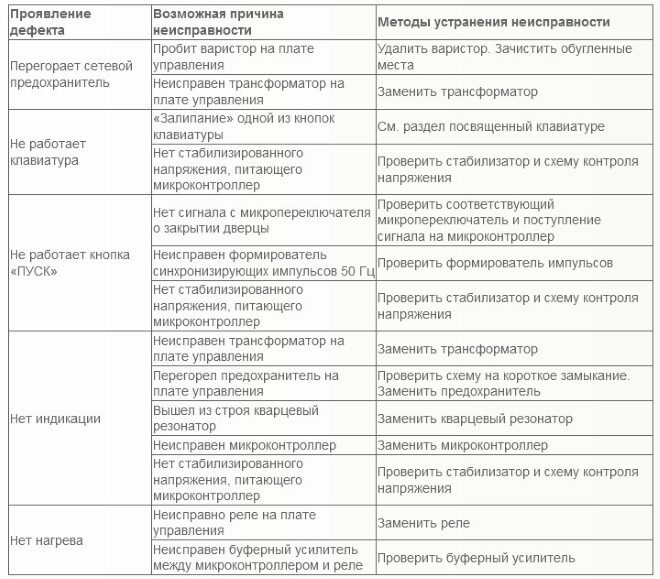
Control block
In modern microwave ovens, heating time and power are controlled using several sensors and controlled relays (thyristor switches) connected to the control board.
2 situations are possible:
- One of the sensors or thermostat does not work. In this case, the heating of the products may be short-lived, since the sensor sends an erroneous signal to the control unit about reaching the limit temperature.
- The control unit itself does not work.
The front part can be equipped with a touch panel or conventional buttons. If it is not possible to switch the heating mode by pressing the sensor or the digital display shows the wrong value, then the problem is definitely in the block.
The control board with buttons breaks less often. Push-button control may not work only if the wire is broken or the silicone cuff is damaged, which protects the contact point from contamination.
Do not try to start heating without a block, there is a risk of overheating and damage to the working components of the microwave. Electronic components of microwave ovens are not repairable.
DIY repair
The microwave oven is designed and manufactured so that the least valuable parts break if used incorrectly or if the heating power is exceeded. First of all fuses. But sometimes there may be more reasons why the device does not work.
First, we remove the casing lining, only the front panel with the door remains.
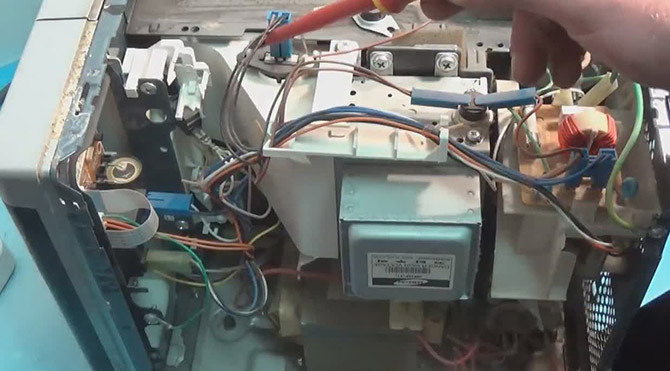
Behind the high-voltage transformer you can see the details, damage to any of them leads to a situation where the microwave seems to work, the panel glows, but there is no heating. This is a high-voltage fuse (in a red case), a capacitor and a diode.
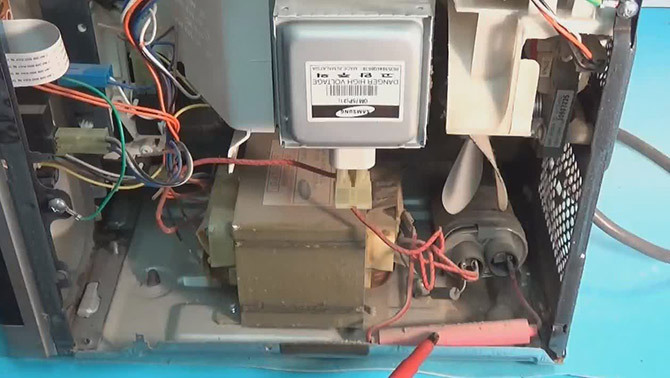
Checking the high voltage fuse
Always checked first. First you need to discharge the capacitor. We hook the "crocodile" on the case, with the second end (a probe with a resistance of 10 MΩ) we touch the contacts on the capacitor.
Next, disconnect (remove the terminals) the fuse box and divide it into 2 halves. Call right away. If the device showed a gap, then the magnetron was left without power, and there can be no heating in principle.
It looks like a whole fuse, the spring is stretched to its full length.
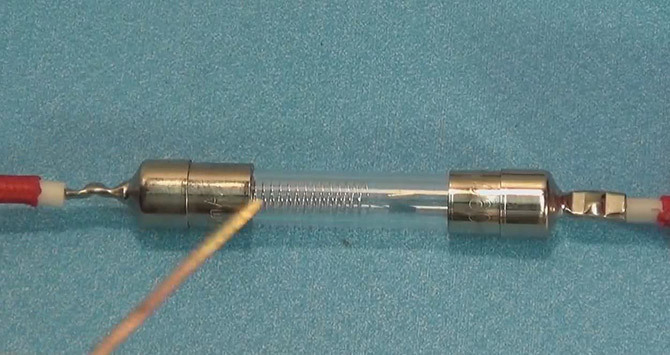
And so - burned out, the springs are not visible, on the glass there are traces of the evaporated metal of the fusible insert.
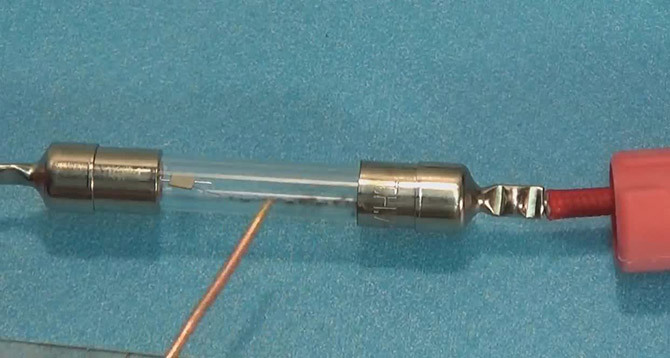
The design of the fuse is such that at the moment of burnout, the spring stretches the contacts, preventing an arc from forming. Otherwise, at the moment of heating the products, the transformer and magnetron would burn out.
Capacitor check
The next step is to check the capacitor. If, when touching the probes to the terminals, the multimeter showed a breakdown, then the capacitor is definitely damaged.
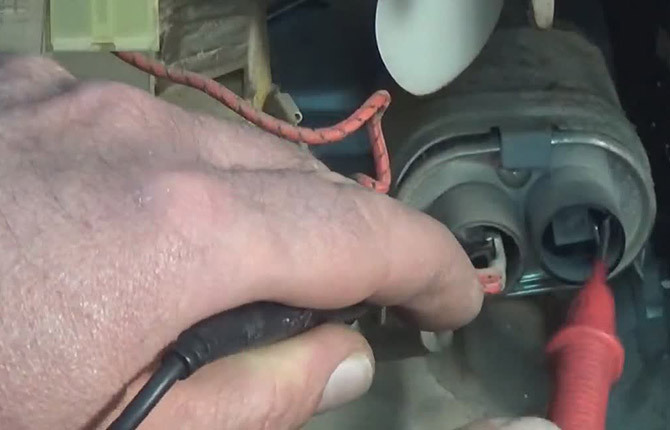
Inside the capacitor there is a ballast resistance, which discharges the remainder of the charge after the heating operation stops. Therefore, the device is not “0”, but 2 MΩ. The capacitor needs to be replaced, it is possible for a new one, but it is better for a used one. They are removed from microwaves that will no longer work and sent for disassembly. Their quality is as good as new.
To check the capacitance, set the multimeter to a measurement limit of 20 MΩ, after which you need to touch the contacts with the probes. The readings of the device should increase, which indicates the accumulation of charge.

You can put the part on the microwave and check the heating. But when choosing a capacitor, you need to be careful, all those that have passed the test will work, but not everyone fits inside the microwave housing.
High Voltage Diode Test
It sits directly on the condenser. You can remove the terminal and send it for testing. The high voltage diode is rated for 4000 V operating voltage, so you can check how the device works for internal leakage.
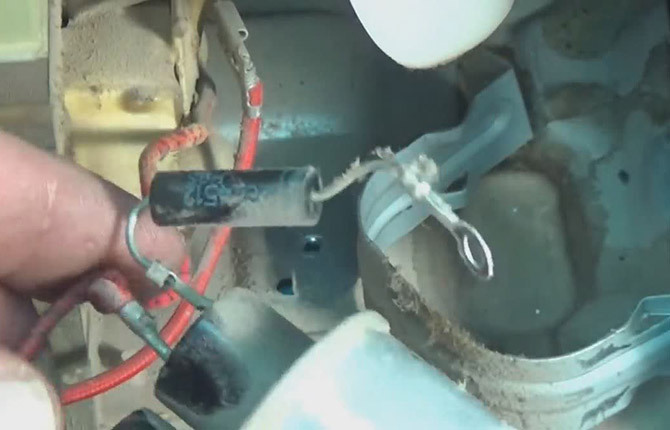
You need to put the multimeter on continuity and check the diode in the forward and reverse direction. If the diode is working normally, then the device will show a break.
The diode can be checked by connecting it to the network through an incandescent lamp. The lamp should dimly flicker. This means that the diode is working.
Magnetron protection test
Another reason why heating may not work is the blockage of the device that generates the microwave field. The magnetron gets very hot during operation, so a thermostat is installed on it (usually from above). In the normal position, the device is closed. If the magnetron overheats due to prolonged operation at maximum mode, the thermostat opens the contacts.
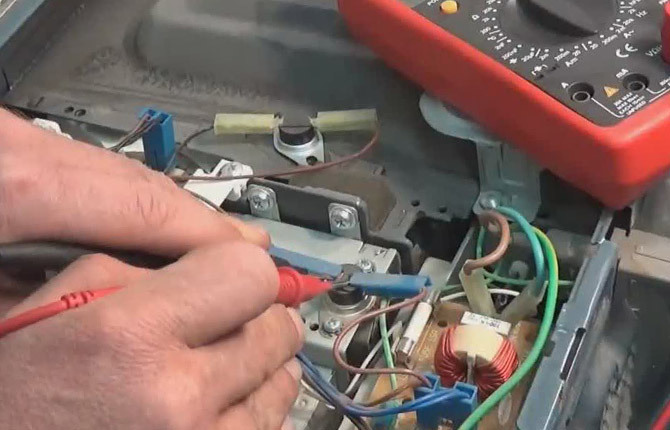
You need to remove the protective pads and ring the device. If the multimeter shows a short circuit, then the thermostat and, most likely, the magnetron are in working condition.
Checking the door sensor
The reason why the microwave heating does not work may not be hidden in the electronic parts. Therefore, it is imperative to check the door closing sensor. In addition to the latch that fixes the door, a microtumbler or “mikrik” is installed on the lock. The contacts of the device are displayed so that you can check how the lock works.
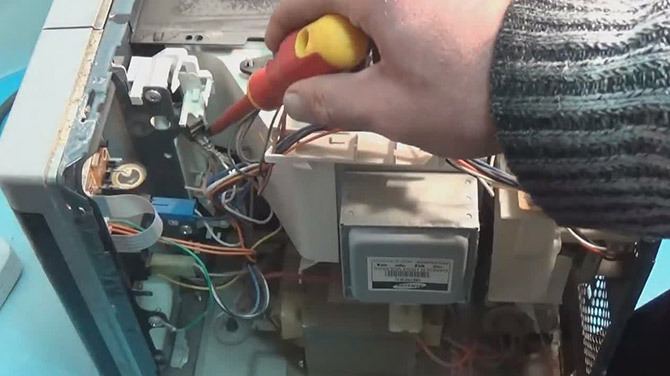
The microtumbler can turn sour from dirt, but more often the terminal on the contact just falls off. If the chip dangles, then you need to slightly compress the terminal. Then we connect the device to a continuity and open it several times - close the door, if the micro-toggle switch works (closes and opens the circuit), then the problem of the lack of heating lies elsewhere.
At the same time, you can check the condition of the mains fuse. But that's more of an oversight. If everything works in the microwave, except for heating, then the mains fuse is also in working order.
After completing all the repair manipulations, you need to assemble the microwave and check how the heating works. To do this, pour water into the cup, put it in the chamber and start heating at medium power for 40 seconds. If the water is hot, then all components of the microwave are working.
Fault Prevention
A microwave oven is a rather complicated device. Many components and mechanisms require regular maintenance. Moreover, many parts are made of inexpensive plastic and have a thin protective coating.
The microwave can work up to 10 years without major breakdowns, providing stable heating of food, without major repairs. But only if during operation the owners of the stove adhere to the following rules:
- If the voltage in the network is unstable, then the microwave must be connected through a voltage stabilizer.
- Do not connect in the same line with boilers or washing machines, especially when heating products for a long time at maximum power.
- When heating any food, especially frozen food without packaging, you need to use a special dish with a lid or a plastic cap. Wash the walls of the chamber regularly from plaque.
- Do not operate without mica plate.
If you need to check how the heating works, then be sure to put a glass cup or a ceramic cup with water inside the chamber.
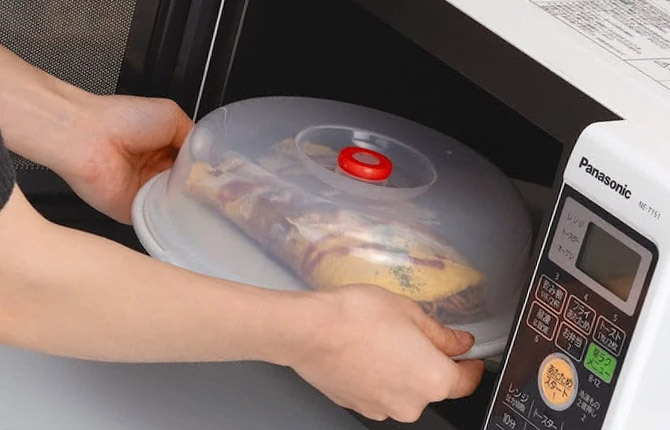
It is strictly forbidden to turn on the stove with metal objects inside. Even foil or an ordinary spoon can cause damage to the transformer. If you're lucky, then experiments with heating will end in a blown fuse.
Wash and clean the microwave should be moderate, preferably without a large amount of detergent. The enamel inside will not be damaged, and the microwave will not stop working, but it is still better to protect the electronics from soapy water.
In order for the microwave to work for many years, try not to cook in the microwave those foods and dishes that can be cooked on a conventional gas or electric stove. Even if the recipe calls for a microwave.
If the stove is regularly “driven” for 30-40 minutes at medium and high power, then in a year heating efficiency will decrease, cracking and smells of insulation will appear, and after a couple of years the device will stop working.
And what definitely should not be done is to dry things, shoes, check how the heating of various objects works. The microwave is designed only for products. Any experiments make it work in an off-design mode, which always leads to a breakdown.
There are as many reasons why microwave heating does not work as there are parts inside it. Each node can cause a malfunction, so the system has to be repaired by sequential enumeration of all possible causes.
Tell us about your experience in repairing a microwave oven, how you managed to restore the heating, what problems you had to face while working with a microwave oven. Bookmark this article for future reference.


